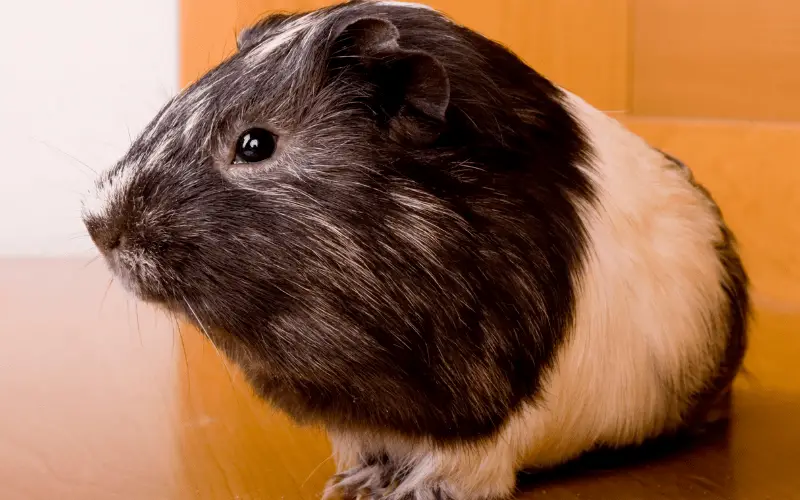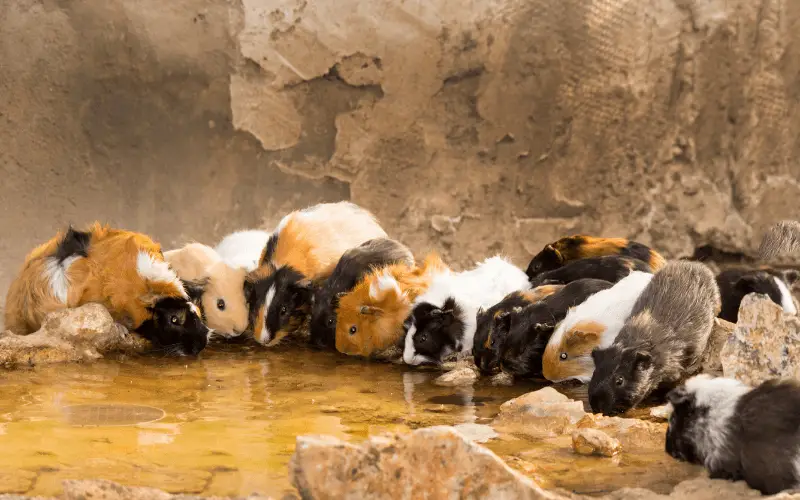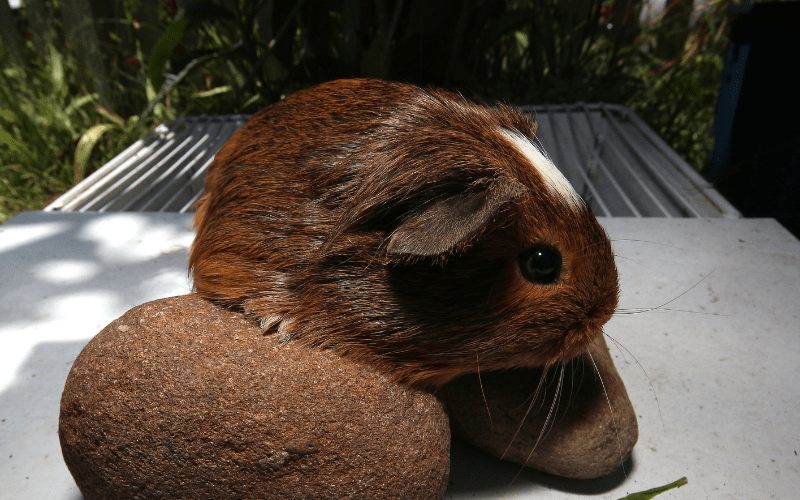Guinea pigs are adorable little animals that make great pets. If you know how to properly feed, play, and care for them, you’re definitely going to enjoy their company. One of the things you need to ensure the health of your piggies is to always keep them at the right temperature.
But can guinea pigs overheat? The simple answer is Yes, guinea pigs can overheat quickly because they react easily to temperatures, making them very sick.
A guinea pig that is overheated needs to be treated by a veterinarian right away, so it will be essential for you to recognize when your guinea pig is feeling hot and provide him the immediate care he needs as soon as possible.
Can Guinea Pigs Overheat?
Guinea pigs can overheat because they are very sensitive to extreme temperatures. For this particular reason, guinea pigs can also catch a cold when it’s too cold and develop heatstroke when it’s too hot.
Note that guinea pigs just can’t develop heat stroke only when exposed outside. They can also become dehydrated and overheated indoors. If your guinea pig has direct contact with sunlight, they are in danger of heatstroke.
Unlike humans that can take over a long period to have a heart stroke, guinea pigs do not have the same liberty. When it’s too hot, guinea pigs only need 10-15 minutes before they start suffering from heatstroke.
Read Also: What Can Guinea Pigs Drink?
How to Prevent Your Guinea Pig from Overheating

1. Provide your guinea pig plenty of water
Your guinea pig needs water regardless of the temperature outside, but it will be even more important to keep him well hydrated in the spring and summer.
Fill his water bottle with fresh, cool water. If you are away from your home during the day, use a large water bottle that will not run too low when you are away.
Consider placing the water bottle on the outside of his cage, leaving only the tip of the water bottle’s snout inside the cage. This would prevent your guinea pig from chewing on and the possibility of damaging the sipper tube.
Put another water inside the water bottle whenever the water level gets low. When your guinea pig is outside, place the water bottle in the part of his run or cage with shade.
The shaded area will keep changing according to the position of the sun, so you will need to move the water bottle periodically.
2. Switch on the AC
When the weather is hot outside, it is best to keep your guinea pig inside. The ideal temperature for your guinea pig is 64 to 68 °F (18 to 20 °C).
The temperature inside your house will have to be considered to know whether you may have to crank up your AC to keep your guinea pig cool and comfortable.
Anyone that is making use of a portable air conditioner should make sure the air is not blowing directly into your guinea pig’s cage.
Any airflow that is direct could lead to an upper respiratory infection. When the thermostat is turned down, make sure your guinea pig’s cage is not in the direct path of the room’s vents.
Fans are suitable for evaporating sweat. But, since guinea pigs are not animals that sweat, fans are not that useful.
3. Keep your guinea pig cool when he is outside
Having outside time is essential for guinea pigs. You will need to take special precautions when you take him out in the spring and summer. For example, take him outside when it is a little cooler – early in the mornings or late in the evening.
If your guinea pig is always left outside in a cage, cover his cage with cool, damp towels to create a cool, shaded area for him. Changing the position of the towels depending on the angle of the sun.
Position a pack of an ice cube or frozen water can in your guinea pigs’ cage. Your guinea pig can lay on them in other to cool himself off. First, cover them in towels, so he does not get too cold or damage the skin on his paw pads.
Place a ceramic brick or tile in his run or cage (whichever is most convenient for you to obtain). They are not absorbers of heat and give your guinea pig something cool on which to lie.
Pouring a large bowl with ice cubes can also be adopted, cover it, and place it in his run or cage. Your guinea pigs can lay against this to keep him cool. Covering it will keep him from falling in.
Spraying your guinea pig occasionally with cool (not cold) water should be considered. Monitor and check up on your guinea pig at least every 20 minutes when the guinea is outside.
4. Groom your guinea pig
Another means of caring for your guinea pig is by taking care of your guinea pig’s coat, it can help keep him cool in the spring and summer.
For instance, when you brush and comb his coat, it can remove excess fur and mats that could trap heat and cause your guinea pig to overheat. The type of combs and brushes suitable for guinea pigs can be gotten from your local pet store.
Use a soft-bristled brush and brush in the direction of the fur, making sure not to pull the fur. You can try to comb the matt out or remove them entirely out with a pair of small scissors.
Seek the help of a second party to wrap the guinea pig in a towel and hold him if you want to use scissors. If the mats are large, try to comb them out over several grooming sessions.
If your guinea pig has long hair, consider grooming it every day. If you can’t groom your guinea pig yourself, consider taking him to a professional groomer.
How To Take Care Of An Overheated Guinea Pig
5. Recognize the signs of heatstroke
Your guinea pig’s small size increases his risk of heatstroke. When the outside temperature reaches at least 82 °F (28 °C), and the humidity is high, he may be at an even higher risk of overheating.
Monitoring the behavior of your guinea pig when your guinea pig is overheating will help you dive into action and get him the care he needs.
Trouble in breathing is one of the signs possessed by guinea pigs suffering from heatstroke, then having a bright red tongue, and starting to slobber (‘wet chin’). They will also become very weak, look depressed, and maybe even begin convulsing.
As a pet owner, you need to be quick with observing when your guinea pig needs to cool down because a guinea pig that is overheated can die if not treated quickly.
6. Invite a veterinarian
Your vet doctor should be able to observe when a guinea pig is overheating. When you invite him, give the veterinary team as much information as you can about the condition of your guinea pig, such as how long he was outside, when you first observed he was overheating, and how he looks now.
Don’t leave your guinea pig exposed to the hot area: Take your guinea pig to a cool part of your house and start giving him first aid. Guinea pigs sweating or panting won’t help them in cooling off, so your guinea pig will not be able to cool off on his own.
7. Try cooling down your guinea pig
it is quite understandable to be scared at how sick your guinea pig looks, but you will need to stay calm and act quickly to help him feel better.
Fill about 1.5 inches (3.8 cm) of lukewarm water into a bowl. Deep feet of your guinea pig in the water for about 10 minutes, letting him stand if he is strong enough to do so. Don’t stop to give him support if he is not able to stand on his own.
Using a sink and putting the same amount of water in a sink and placing your guinea pigs’ feet could be another option if you do not have a bowl nearby.
It is highly recommended that you use lukewarm water. Cold water could put them in shock by cooling them off too rapidly.
Slowly expose their body (e.g., ears, abdomen) with a little bit of water. Do not deep him inside wholly in the water – this could also cause him to go into shock.
Read Also: Can Guinea Pigs Have Too Much Vegetables?
8. Do not give an unconscious guinea pig anything fluid
When a guinea pig is exposed to heatstroke plus dehydration, it may lead to them being a very sick guinea pig, and trying to rehydrate him on your own could make him even more unwell.
For instance, if your guinea pig is having difficulty breathing, he could accidentally inhale the liquid into his lungs. If the guinea pig is conscious, give him water to drink.
9. Take your guinea pig to your veterinarian
Overheating will cause your guinea pig to be very sick so that he will need treatment from your veterinarian as soon as possible.
Use a semi-wet towel to keep your guinea pig cool on your way to the veterinarian’s office.
Make the towel a bit wet with the same lukewarm water from the bowl or sink. You can also cover your guinea pig in a towel.
Make sure to turn on the air conditioning (AC) in your car. You could roll down the windows if the AC isn’t working, but this may not let in cool enough to air to keep your guinea pig cooled down.
Your vet doctor will continue to administer first aid to your guinea pig by keeping him cool and rehydrating him with intravenous fluids.
The veterinarian should also provide your guinea pig extra oxygen if he is having trouble breathing.
Your veterinarian will watch out for your guinea pig intensively for signs of organ damage or failure due to heatstroke. This involves taking blood samples.
Your guinea pig should be kept in a cool, quiet, and dark area of your veterinarian’s office; he will recover there. Expose him to the same type of place when you bring him home.
How to Keep Your Guinea Pigs Cool During Heat

When there is the sun, carry your guinea pigs’ hutch into a cooler place, either in a shaded area, under a parasol, or inside your home in a cool room out of direct sunlight.
You can use a fan to keep the air cool and create airflow, so, therefore, do not blow the fan directly onto the guinea pigs and ensure they have enough room to move away if they wish.
Place a cold rung out towel over the run to provide shade, and the fan can be blown onto this to help lower the temperature.
When using a towel to cover a cage, be careful enough not to cover the whole hutch as the guinea pigs will still need airflow to keep cool, and make sure that the towel isn’t soaked and dripping water to avoid drenching them. Cooling hutch covers can also be purchased.
Place a frozen large bottle of water or ice packs wrapped up in an old towel in the hutch. By so doing, when your guinea pig is feeling hot, they can lie next to the bottle to keep cool.
Purchasing a special self-cooling mat should be considered, which can be placed on the floor of the hutch or run to lower temperatures and provide respite from the heat.
Another option is the introduction of marble tiles or slates into a cage and keeps it cool so your guinea pigs can lie on it if needed.
Tiles when exposed directly to sunlight, become extremely hot, so be careful to keep the tiles in shades.
Always make available plenty of fresh, cool water for guinea pigs to stay hydrated and regularly check that the water spout isn’t blocked. Provide more than one source.
Always think of serving fresh leafy greens from the fridge to your guinea pig or soaking your guinea pigs’ leafy greens in icy water.
Vegetables that are rich in water such as cucumber can be fed in moderation (too much can cause tummy problems) to add more water to your guinea pigs’ diet at times of extreme heat.
Always think about exposing to them a human-made burrow in your guinea pigs’ enclosure for them to go down into out of the sun or introduce hideouts for them to chill out in but stay away from any shelters made from plastic as these can get too hot.
Brush out any excess fur which can significantly affect long-haired guinea pigs and will make them feel hotter and more uncomfortable in the heat.
Slightly wet the fur of your guinea pig with a damp cloth to help them cool down or, if they are comfortable with it, spray a fine water mist (you’ll need to do this gently and at a distance at first).
What Can Guinea Pigs Eat?
If you are looking for more information, walkthroughs and troubleshooting about Guinea Pigs and their diet, here are some additional posts you can check out:
Conclusion
As earlier explained in the article, guinea pigs can overheat, and if left unattended to can result in more severe conditions; this can lead to the guinea pigs having heat strokes.
When this happens, don’t try saving them yourself because it might cause death. If you don’t have the necessary skills, take them to a vet.
This article has explained ways to prevent such incidents from occurring.
PeSandy Rabbit Cooling Pad

Made of high-quality aluminum material, have super thermal conductivity. It is colder than organisms and can take away the heat of pets to keep them comfortable.
Product SKU: B07T51TYF1
Product Brand: PeSandy Rabbit Cooling Pad
3.8
Pros
- Stays cool and comfortable pad
Cons
- Small and peels or scrapes easily
